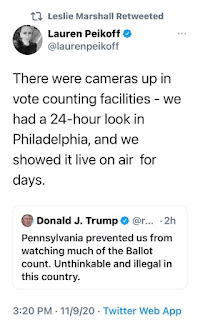This map was lifted from the New York Times and reflects data current as of yesterday. The darker the area, the higher the COVID rate. If a person looks closely, that person may notice that the county where I reside, the one I usually think of as being safely in the middle of nowhere, sports the darkest color provided. Things are not good here, and, based on my casual observations while running errands (post office, grocery shopping, and not much else), I am not optimistic about things improving any time soon. Case numbers keep climbing; so does the death rate.
A Facebook acquaintance, someone I know out in the real world, too, but haven't seen in person for so long she's slid into being a virtual friend, commented that the recent spate of deaths didn't worry her -- she didn't know any of the people who died. News flash: it doesn't matter. Viruses are like urban legends. All it takes is a friend of a friend to pass it along. The experts are pretty well united on the way COVID-19 is traveling now is primarily community transmission. You know, someone is walking around infected but asymptomatic, that someone doesn't bother wearing a mask in the lobby at the post office or while shopping at Larry's, the virus hangs in the air (viruses are tiny; they can float around for hours before settling on surfaces), other people inhale it, and the next thing you know a dozen people who were unlucky enough to be in the store when Joe Asshole picked up his case of bad beer are now infected too. Because Joe Asshole figures he didn't need to wear a mask in a public place. Because, you know, Freedom.
A small digression: I have absolutely no idea why the public health community spent so much time telling us all to wash our hands and be careful about what we touched when COVID-19 is so clearly airborne. The virus enters the body through respiration; it spreads when you cough, sneeze, or simply exhale. Airborne. Masking was (and is) a whole lot more important than bathing in Purell. Hand washing and sanitation are important, but I think they got emphasized at the cost of not making the masks seem as important as they are. I'd read descriptions of super spreader events and wonder again why the experts weren't laying it on thick about airborne infections. I mean, when you have half the people at a choir practice getting sick did the epidemiologists seriously believe that the victims all contracted the illness from touching a restroom door handle?
In any case, those of us who do worry enough to keep wearing face masks might as well brace ourselves for another six or seven months minimum of doing so. Yes, I know there is hope a vaccine (or vaccines) will be out in December. But what are the odds it's going to reach the average person quickly? It took me three trips to the Houghton Walgreens to get a flu shot; the first two times they were sold out. How fast and easy can we realistically expect obtaining a COVID vaccine to be? The answer is probably "not very."
I'm not the only pessimist drifting around who thinks some of the euphoria over vaccine breakthroughs is a tad premature. Tony Fauci doesn't think we'll be back to a possibly maskless society until sometime next fall, like maybe the last quarter of 2021. By then masks may have moved securely into one of those fashion accessories you don without thinking, like gloves in the winter.
Last spring the Younger Daughter and I were talking about the then very novel pandemic. I told her the way things were going (and this was back in April) that COVID-19 was going to move from being epidemic to being endemic. It was going to make a first pass through the population, pick off the most vulnerable, subside, and then come back and do it again: knock off the most vulnerable persons, subside, and then do it again. Each time around the death rate would be lower, not necessarily because we'd have gotten better at treating it but because there were fewer vulnerable people.
At the time, this pattern (aka seasonality) was a hot topic on the Sirius XM channel I could hear for free in the Focus. (I let my Sirius subscription lapse because I didn't spend enough time in the car to make it worth it, but when the pandemic hit Sirius opened up a few public interest channels.) I'd shelter in the shade of the Sparklight pole at the Graham County Fairgrounds, wander around the Intertubes on my notebook, and listen to various medical experts talk about COVID. Seasonality, a pattern of surging at certain times of the year, was seen as a definite possibility. My thought was it would resemble seasonal influenza: hit hard in the cold weather months, make whole bunches of people sick, bump up the death rates in nursing homes, and then go away for a few months.
Is that what's actually going to happen? I have no clue. It's equally likely the virus could decide to be like the Spanish flu, the strain of influenza that caused a global pandemic at the end of World War I. That flu hit hard in 1918 and 1919 and then seemingly disappeared. The winter of 2020-2021 could be the last one where we worry about this particular corona virus. You never know.























